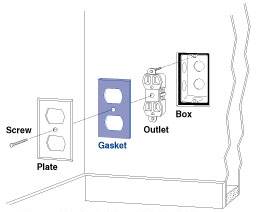Once you have performed any air remediation work on your home you should redo the test to ensure that you have not created a problem and an unsafe situation.
If you only have powered vented appliances in your home you do not need to be concerned about back drafts.
Power vented furnaces, and boilers use a powered fan to ensure that exhaust gases do in fact exit your home. With a powered vent appliance the combustion chambers are sealed and the air needed to support combustion is drawn into the home through an intake pipe and flue gases are exhausted through another pipe.
This method completely isolates the appliance from the indoor air and hence what ever air remediation actions you undertake will have no affect to the health and safety of the occupants in your home.
- Moisture
- Indoor air quality
- Gas or kerosene space heaters
- Gas cooktops and stoves
- Bathroom ventilation
The tighter your home the higher the moisture content of the air. To much moisture can cause wood to rot and mold to grow.
The tighter the home the harder it is for basic day-to-day contaminants to escape. Fumes and vapors from cleaners, paints and other chemicals that we use in our lives will not dilute as quickly in an air tight home.
If you use any appliances that do not have outdoor vents you should not take any further air remediation steps until those appliances are either properly vented or removed from your home. Gas and kerosene space heaters produce carbon dioxide, water vapor and if they are not functioning properly they can even emit carbon monoxide.
Both of these appliances exhaust large quantities of moisture into the home. Some will even produce quantities of carbon monoxide when they are turned on. Gas cooktops and stoves should be vented using range hoods or other powered ventilation techniques. If you have either of these appliances in your home and they are not vented correctly you should not commence air remediation work until these appliances have been properly vented.
The bathroom exhaust fan is designed to remove water vapor from your home at one of its largest sources. You should ensure that the bathroom exhaust fans are working properly. To test your bathroom fans, with the bathroom door open hold a lit cigarette or incense stick near the ventilator and ensure that the smoke is exhausted from the bathroom. Try the test again, this time with the bathroom door closed. If the smoke was exhausted when the bathroom door was open, but not when it was closed, you must trim the bottom of the door to allow more air into the bathroom or install a ventilation grill on the door or wall. If the smoke is not exhausted with or without the bathroom door closed you need to replace the fan and/or its vent system.
Air Sealing Materials
In order to perform an air remediation on your home you will need a variety of different sealing materials and weather stripping:
- For larger holes rigid and sheet materials along with expanding foam perform best.
- Caulk is an excellent sealant for areas around window and door frames as well as other seams and cracks. There are many types of caulk available. Some adhere better to certain materials than others. Some will last longer and still others can be painted while others cannot. Always read the manufacturer's labeling before choosing a specific caulk for a specific task.
- Weather stripping works well around windows and doors providing sealing when they are closed.
Additional information on: Caulk
Additional information on: Weather stripping

Figure 3: Install gaskets behind cover plates for all electrical receptacles and switches including those on interior walls. It is always wise to turn off the power before installing the gaskets.
- Gaskets will be needed for electrical boxes as shown in Figure 3.
- Specialized caulking or sealants for use around high temperature areas such as chimneys, fireplaces and other flues.
Looking for Air Leakage
There are many areas that present obvious air leakage.
In general air escaping into the attic is the number one area for heat loss in a home from air leakage.
Note: We are discussing air leakage not the insulation quality of the home. Single pain, glass windows are the number one area for heat loss in a home.
The number one attic heat loss is the entry access to the attic.
Additional information on: Insulating the attic access.
Apparent air gaps in door and window frames may or may not extend from the interior of the home through to the exterior.
The best method to test for air leakage is to have a blower door test done on your home. If however, this is not within the homeowners budget, you can spot drafts by running your hand around door frames and windows on a windy day.
Your top priority, for sealing and providing air remediation to your home is to start with the attic.
